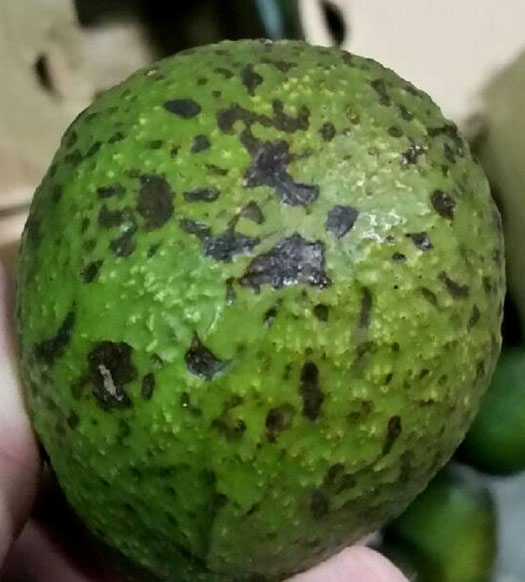You may be reading this post and wondering, “what the heck is cercospora spot?” Avocados can be a bit tricky to inspect unless you are involved with the growing/shipping processes. To begin with, the USDA has issued a grade standard for Avocados grown in Florida. Mexican avocados are not “technically” covered by this standard, but everyone, including the USDA inspectors, will use the Florida Avocado Grade Standard as their guide when inspecting avocados from locations other than Florida.

So let’s assume you are inspecting Hass Avocados from Mexico and you find this defect, pictured above. Checking the USDA Inspection Instructions the defect you have found is most likely Cercospora Spot. The instructions state: Cercospora Spot is caused by a fungus that is able to infect previously uninjured fruit and leaves. Spots on fruit appear as small-scattered greenish-white dots, which are generally 1/4 inch or less in diameter. These spots later develop into slightly sunken, light to dark brown spots of definite outline but irregular shape. A fungus often develops on the surface of these spots. The affected surface usually becomes cracked or fissured. Although the fungus is confined to the rind tissue, the dead, cracked tissue made in the rind allows an entrance for anthracnose and other decay organisms. The scoring guideline states that this defect is a free from defect, so if you find any amount it is scored as a defect, as damage, against the 10% tolerance for total defects.
If you thought this defect was Anthracnose, you may have a pretty good argument. The USDA Inspection Instructions state: Anthracnose is caused by a fungus. Anthracnose infections are slightly sunken and nearly circular in shape, dark brown to black, and vary from tiny spots to 1/2 inch or more in diameter. As the fruit ripens, the Anthracnose infection spreads rapidly into the flesh, causing a greenish-black fairly firm decay. The surface of the lesion may develop radial cracks and will show pinkish spore masses of the fungus during moist periods. Sounds very similar to Cercospora Spot, except Anthracnose typically has circular discolored spots while Cercospora Spot has irregular shaped discolored spots. Is the scoring guideline any different? Anthracnose is scored as a free from defect, but is scored against the 5% tolerance for Anthracnose and Decay.
So, this is where it gets a bit confusing. Since Mexican Avocados are not covered by any US Grade Standard (only Avocados from Florida), there are no official tolerances, since the tolerances are written into the grade standard. If you called the defect Cercospora Spot or Anthracnose in our example for Mexican Avocados it really does not make much of a difference. Both are caused by a fungus, both are condition defects, and both are free from defects.
But, in our example, which was a real situation, what did the USDA call this defect? The USDA Inspector who inspected these avocados didn’t call this defect Cercospora Spot or Anthracnose. He described the defect, as numerous brown to black discolored spots. For those that have taken my training class you have heard me say one thing over and over, “if you are not sure of the specific name/cause of a defect, then simply describe the defect.” The USDA inspector did exactly that, not sure of the defect, he described the defect, perfectly acceptable. But shouldn’t the USDA Inspector have known this defect? I will leave that up to another post.

2 Comments on “Avocados- Cercospora Spot”
Hey Tom: Yes, I would read the book and come to the conclusion it is Cercospora Spot but would be told by my oic that I am not a pathologist and cannot definitively say it is CS. What do we do when we think we know what we are talking about but have not had proper training or guidance to follow through? Back in the day we inspectors would get together with the supervisors and have discussions regarding defects and what to call them. Nowadays, it is so much easier for the inspector and the rest of the staff to simply describe it. I do not agree with this strategy but my hands are tied. Too often the supervisors nowadays do not want to put their neck on the line. Wouldn’t it be better if the trainers and supervisors would get together and tell all inspectors just what the defects are?!
Hi Tom, thank you very much for all your help. Your website always help me when I am confused or I have any question about different products.
Very good information and pictures.
Thanks